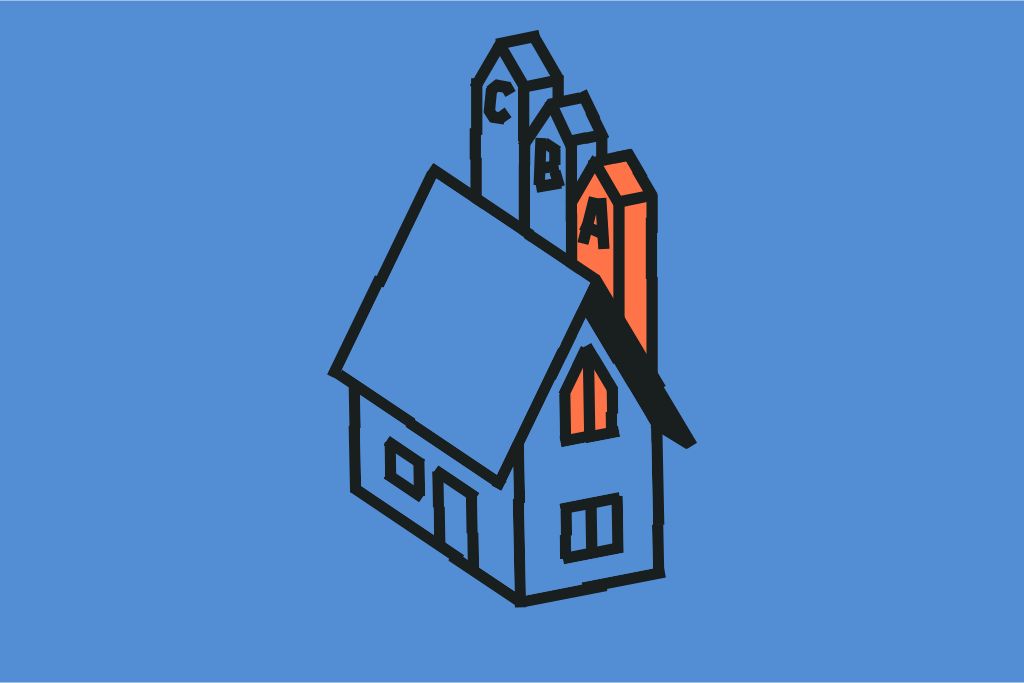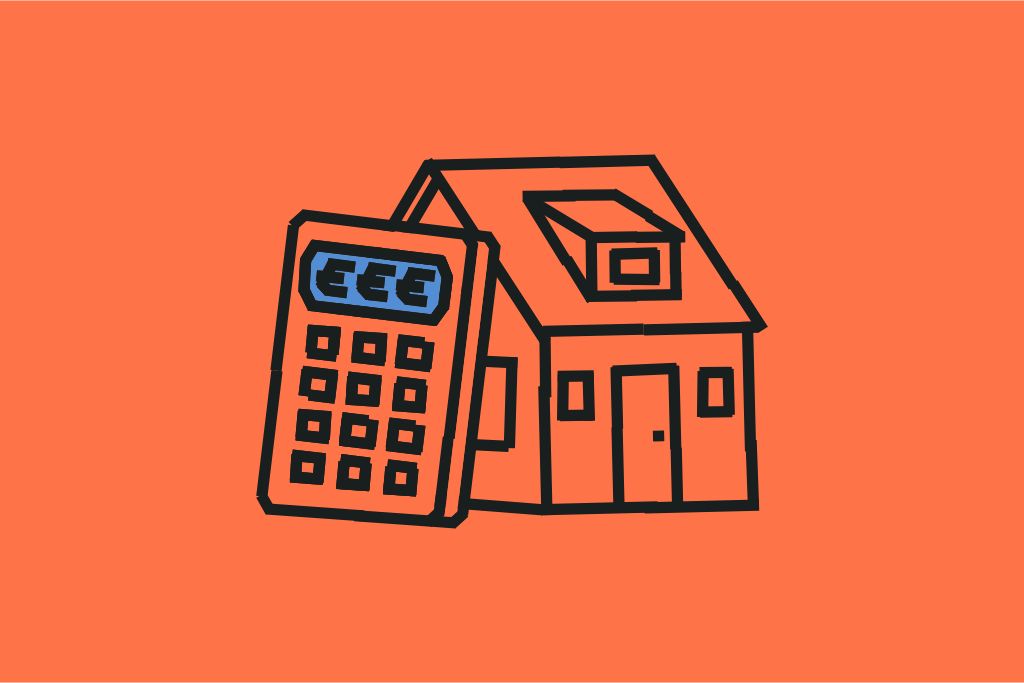What is energy label E?
Energy label E means that your home is not energy efficient. A house with energy label E uses on average between 290 and 335 kWh per m² per year. This is a fairly high energy consumption compared to the average Dutch home.
A house with energy label E is often poorly insulated, has single or old double glazing and an outdated central heating boiler. Little use is made of renewable energy sources such as solar panels or heat pumps. For you this means: a high energy bill, less comfort and often less favorable mortgage conditions.
Want to know what energy label your home has? Request a new energy label easily.
{{cta}}
When do you have energy label E?
You get energy label E when the average energy consumption of your home is between 290 and 335 kWh per m² per year. This is the main condition for obtaining this label.
Characteristics of a home with energy label E
- Poor insulation of roof, walls and floor.
- Single glazing or aged double glazing.
- A central heating boiler that uses a lot of energy.
- Hardly deployment of renewable energy.
- Relatively high energy consumption, resulting in high energy bills.
This means your home scores worse than average, but not yet as inefficient as a home with energy label F or energy label G.
Want to know exactly how the labels are structured and what their requirements are? Read our article explaining energy labels A through G.

Advantages and disadvantages of energy label E
Energy label E mainly means high energy costs and less living comfort, but also a lower purchase price and room to improve the home. Read the details below.
Advantages of energy label E
- Lower purchase price: houses with label E are often cheaper than the same house with a higher energy label.
- Improvement potential: you can use various measures to improve the home and increase its value.
Disadvantages of energy label E
- High energy bills: your home uses more energy than average, which increases your monthly bills.
- Lower living comfort: poor insulation and drafts cause cold and less pleasant living.
- Lower home value: the same home with energy label C or energy label A usually fetches more.
- Less favorable mortgage terms: banks do not offer additional borrowing space and are stricter with low labels.
{{cta}}
Energy costs of a house with energy label E
A home with energy label E costs on average €10,125 per year in energy, which amounts to about €844 per month for a single-family home of 120 m².
This is based on an average consumption of 290-335 kWh per m² per year and the current electricity price of €0.27 per kWh in September 2025, according to the ANWB. In practice, energy costs may vary from one home to another. This depends on various factors such as insulation, the number of occupants, the type of home and energy use.
In comparison, that is about €3000 per year more than for energy label C (± €250 per month) and over €5800 per year more than for energy label A (± €486 per month).
Want to know how your home scores and if you can get a better label? Easily request a new energy label.

How do you improve energy label E?
You improve a house with energy label E by improving insulation, renewing installations and generating your own energy. These steps will make your home more energy efficient and increase your chances of achieving a higher label.
Key areas of improvement for a home with energy label E are:
- Cavity wall insulation or roof insulation: prevents heat and energy loss.
- Floor insulation: reduces cold and energy costs.
- HR++ or triple glazing: better insulated glass reduces energy consumption.
- New boiler or (hybrid) heat pump: replace an outdated system with a more efficient alternative.
- Solar panels: generate your own power and lower your energy bills.
- Improve ventilation: for healthier indoor environment and less heat loss.
These measures make your home more energy efficient and reduce your energy consumption, which directly saves on energy costs and improves living comfort.

What does energy label E mean for your mortgage?
With energy label E, you won't get additional loan space on top of your maximum mortgage.
Houses with energy label C or D often receive €5,000 extra, and houses with energy label A or B even €10,000. For a home with energy label E, this benefit does not apply.
However, there is an exception: if you take energy-saving measures, you can borrow extra. For label E, you can borrow up to €20,000 extra, provided you use this amount to make your home more sustainable. Think of insulation measures, a heat pump or solar panels.

Frequently asked questions about energy label E
After reading this article, do you still have questions about energy label E? You're not the only one. Below you will find the answers to the most frequently asked questions. So you know exactly what energy label E means, what the costs are and how you can improve your home.
Is energy label E economical?
No, a house with energy label E is not economical. The label shows low energy efficiency and poor energy efficiency, with an average consumption of 290-335 kWh per m² per year. This means higher energy costs and less living comfort than a house that is better insulated.
What is the cost per month of a home with energy label E?
A home with energy label E costs an average of €844 per month in energy. This is based on a single-family house of 120 m² and an electricity price of €0.27 per kWh according to the ANWB. An energy advisor can advise you on what modifications will help to reduce your consumption and thus get a lower energy bill.
How do you improve a home from energy label E to A?
You can bring a home with energy label E to A by investing in insulation, solar panels and a heat pump. These modifications increase the insulation value and provide substantial energy savings. This makes your house very energy efficient and better for the environment.
How do you improve a home from energy label E to B?
Upgrading a house with energy label E to B can be done in several ways: better insulation, HR++ glass and a hybrid heat pump. This improvement makes your home more energy efficient, lowers your dependence on gas and increases your living comfort.
How do you improve a home from energy label E to C?
You go from label E to C through smart improvements such as roof insulation, cavity wall insulation and HR++ glass. This way you can optimize the energy efficiency of your home and save on your energy costs. These measures also benefit the environment and make your home more attractive on the housing market.
How much does it cost to go from energy label E to A?
The cost to improve a home with energy label E to A is often between €15,000 and €25,000. These include recommendations such as insulation, solar panels and a heat pump. A licensed energy consultant can advise you which improvements are wise for your home and situation.
{{vragen}}
Comparing energy label E with other energy labels
Energy label E means that your home uses an average of 290 to 335 kWh per m² per year. This means that your house has a fairly high energy consumption and the energy costs are considerably higher than for a house with label C or B.
Energy consumption by label
Want to know exactly what each energy label means, including features and examples? Then read our article on what energy labels A to G mean.
Read about the other energy labels
- What does energy label A mean?
- What does energy label B mean?
- What does energy label C mean?
- What does energy label D mean?
- What does energy label F mean?
- What does energy label G mean?




